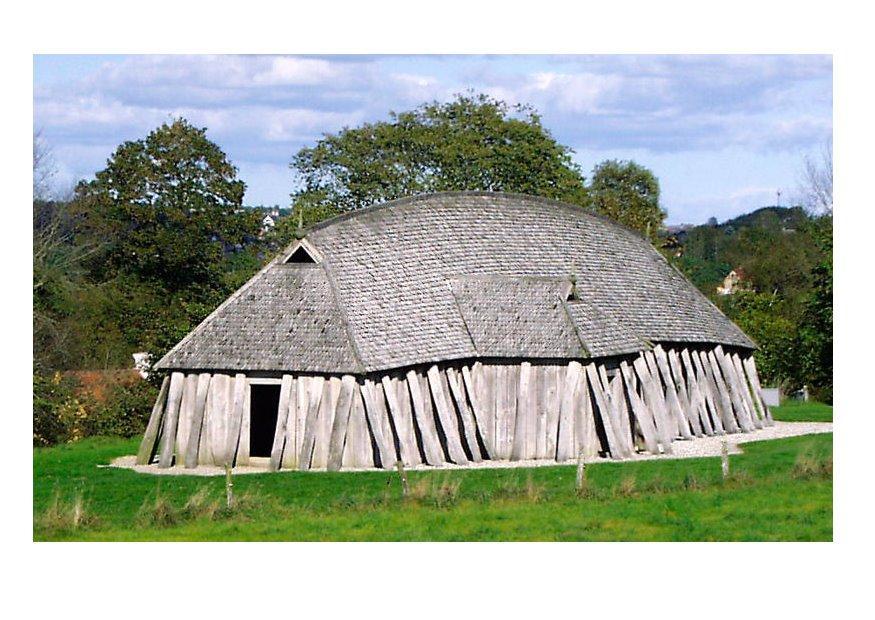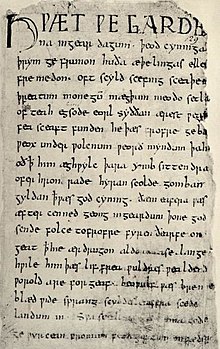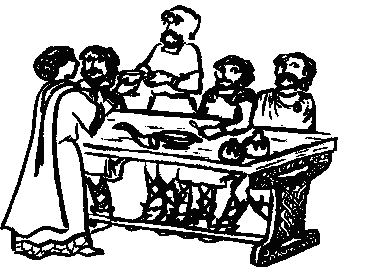It is this ‘loud merriment in hall’ which Grendel hears and hates from the beginning, while Hrothgar’s poet sings ‘clear in Heorot’ on every one of the three night Beowulf spends there. 64-65) Mead-halls offered protection and peace, since the world portrayed in the Anglo-Saxon poem is set in a dangerous time – the idea of the. Beowulf is also the name of the main character, a hero of a Scandinavian tribal people known as the Geats. The story pits Beowulf against a merciless monster known as Grendel, who breaks into the mead hall of the King of the Danes to wantonly maim and kill members of King Hrothgar's court. Answered by jill d #170087 3 years ago 9/4/2017 7:05 PM Heorot is Hrothgar's great mead hall, constructed for his warriors. It is a place for gathering. And Hrothgar's palace. It is described as 'the foremost of halls under heaven', constructed of timber and gilded in gold.
February 8, 2011Bollermann
Lord or Lady:Wealhtheow's role as cupbearer in Beowulf
...Wealhtheow came in,
Hrothgar's queen, observing thecourtesies.
Adorned in her gold, she graciouslysaluted
the men in the hall, then handed thecup 615
first to Hrothgar, their homeland'sguardian
urging him to drink deep and enjoy it
because he was dear to them. And hedrank it down
like the warlord he was, with festivecheer.
So the helming woman went herrounds, 620
queenly and dignified, decked out inrings,

offering the goblet to all ranks,
treating the household and theassembled troop,

until it was Beowulf's turn to take itfrom her hand.
With measured words she welcomed theGeat 625
and thanked God for granting her wish
that a deliverer she could believe inwould arrive
to ease their afflictions. He acceptedthe cup,
a daunting man, dangerous in action
and eager for it always. He addressedWealhtheow; 630
Beowulf, son of Ecgtheow, said:
“I had a fixed purpose when I put tosea.
As I sat in the boat with my band ofmen,
I was meant to perform to the uttermost
what your people wanted or perish inthe attempt, 635
in the fiend's clutches. And I shallfulfill that purpose,
prove myself with a proud deed
or meet my death here in themead-hall.”
This formal boast by Beowulf the Geat
pleased the lady well and she went tosit 640
by Hrothgar, regal and arrayed withgold



Women inAnglo-Saxon society were expected to fit certain roles that woulddeem them as honorable and valuable to their community. These roles,namely cupbearer and peaceweaver, are associated with the honor ofthe society and the bonds of friendship between communities. Thecupbearer is the more active role, by which a woman bestows themead-cup to the warriors as a symbol of the community's valor as wellas the individual honor of the soldiers. The role of peaceweaver isascribed to a woman who is given away through marriage to anothertribe in order to establish peace. In both of these roles, the femaleacts as a symbol through which the tribe's honor and valor isdisplayed. In Beowulf, Queen Wealhtheow embodies the idea of a goodqueen, and exemplifies the qualities and role of an honorable womanin Anglo-Saxon society. Early in the narrative, Wealhtheow acts as acupbearer in the mead-hall, inciting Beowulf's boast to defeatGrendel, and while this may seem like a passive role in which she isobjectified, her role as cupbearer is empowering; it honors her aspowerful, especially for her femininity, and even allows her to takeon responsibilities and privileges bestowed to a lord.
Wealhtheow isdeemed to be a good queen; therefore, she must exemplify what isconsidered to be good behavior for a high class woman in Anglo-Saxonsociety. The first description of her is of her being “adorned ingold” (Heaney line 614). She is dressed in treasure which signifiesboth the prosperity of the tribe and her worth to her people. Whileshe is acting as a figurehead, she is given great honor by heradornments which is essential in Anglo-Saxon culture. Besides being apassive symbol of honor and wealth, the passage also describes heractive role of serving the men from the mead-cup in a decadent andhonorable fashion, describing her as “queenly and dignified,/decked out in rings,/ ” (621). Here it becomes clear that her honoris not only tied to her physical beauty and adornments, but that thephysical aesthetics are ornamenting an actual purpose or role that isworthy of being hailed or honored through material wealth, which inthis instance is the role of the cupbearer. Wealhtheow, while livingin a patriarchal society, is empowered by her role as queen, and morespecifically cupbearer and symbol of cultural valor, as seen by thephysical adornments bestowed upon her.
Wealhtheow's roleis therefore not only physically symbolic of honor, but she is alsodescribed as “observing the courtesies” (613), which ascribes herwith the proper decorum expected of her royal status. Here it appearsthat the courtesies in the mead-hall, clearly the most importantestablishment in Anglo-Saxon culture, greatly involve respect to theking, Hrothgar, who she serves first and hails as the guardian of theland. She then continues her rounds and serves each of the warriorsin the comitatus. While this appears to be a subservient role, thisrole of cupbearer is actually one of great importance. By serving themen from the cup, she becomes a symbol for the glory of their landand society by nourishing them.
The cup itself is asymbol of battle and wealth, both important aspects of the warriorculture of the comitatus. However, it is also a symbol of nourishmentand, in the dogma of the Christian monks who are responsible fortranscribing the poem, a symbol of the power of Christ who heals andredeems. Thus, the cup becomes a dual symbol, representing themasculine aspects of the warrior culture as well as the traditionallyfeminine aspects of nourishment and healing. The cup itselfrepresents the maternal role that Wealhtheow fills for the warriors.By giving the mead-cup to her lord, she becomes a life-giver,replenishing him. The passage also makes sure to point out that sheserves Hrothgar first since he is “their homeland's guardian”(616). Thus she nourishes the warrior who protects the land, givingher a natural motherly role. This notion is quite pagan and brings tomind the idea of the correlation between nature and woman,exemplified by woman's ability to bear children. Nature itself is apowerful force in Anglo-Saxon society. For example, a storm may beused to represent the dangers and uncertainties in life, this is seenin Bede's analogy of the bird in the hall. Bede describes life as abrief interlude of pleasure and warmth in a hall surrounded by astorm. Femininity in Anglo-Saxon culture then becomes somethingrelated to the power of nature, and thus garners some respect. Womenbring together the power of nature and the structure of society. Therespect that this relationship garners in Anglo-Saxon society is seenin Wealhtheow's maternal role in the mead hall.
Wealhtheow ishonored as a woman in the cupbearing society, but the ceremony alsoallows her powers that would normally be given only to a lord. Forinstance, the role of gift-bearing is an essential practice inAnglo-Saxon society that provides a link between a lord and histhanes. The lord gives treasure to his servants in order to bestowhonor upon them and to show their rank to the other thanes andcivilians. In the cupbearing ceremony, Wealhtheow takes on this role,becoming a gift-giver in that she bestows honor on the warriors withthe physical and symbolic reward of the mead-cup. She establishes astrong bond with all of the warriors:
So the helming woman went her rounds,
queenly and dignified, decked out inrings,
offering the goblet to all ranks,
treating thehousehold and the assembled troop (620-4),
This descriptioninvokes the image of a lord giving treasure to his thanes afterbattle, but instead of being on the battle field, the cupbearingceremony is the domestic equivalent of this tradition. She gives themead-cup to all of the men, giving all of her people their fair due.She starts, however, by giving the goblet to Hrothgar, urging him to“drink deep and enjoy it/ because he was dear to them” (616-7).Wealhtheow gives the first drink to the person of highest respect,the king. This shows a connection to the practice of gift-giving inwhich the lord gives the best treasure to those he holds in thehighest esteem. Her command to the king to drink deeply from themead-cup also shows her generosity which is also an essential aspectof gift-giving from a lord to his thanes. It also demonstrates thewealth of the tribe. Wealhtheow is able to function as both a lord aswell as a symbol of the community.
This role ofgift-giver is also emphasized by the physical wealth of Wealhtheow,she is wearing lots of gold. When a lord is rich, he may often showthis by giving away treasure to his men. Wealhtheow, however, wearsthe treasure on her body to show her wealth. This is seen in herdescription at the end of the passage: “She went to sit byHrothgar, regal and arrayed with gold” (641). This passage impliesthat part of her regal appearance is due to her gold adornments, andthis treasure also appears to connect her on the level of Hrothgar.This passage portrays them as sitting side by side, both as lords, orgift-givers. Both wearing of treasure and presenting it to a loyalsubject are ways of displaying one's wealth, but Wealhtheow'streasure, mostly gold, is more of a symbol. Her demonstration ofgift-giving and generosity is embodied in the ceremony of the passingof the mead-cup. While the men are given physical treasure that marksthem as honorable in the field, they are rewarded with the mead-cupat home, a more nurturing prize given to them by the Queen whorepresents the wealth and valor of society. Thus, the gift-givingafter a battle is then contrasted with the mead-cup ceremony at home.After they have protected their tribe through warfare, theircommunity repays them with the ceremonial mead which is presented bya woman, representative of life and birth. This reciprocity is alsoimportant in gift-giving, in which the lord gives treasure to histhanes, and the thanes repay him with loyalty. In this ceremony,Wealhtheow takes on the role of the lord and gives the mead-cup toher people, expecting loyalty in return. The ceremony in themead-hall becomes something much larger and meaningful throughWealhtheow's role as cupbearer; it becomes a ritual of power.Wealhtheow not only acts as a lord, but she also represents herculture nourishing her people, and in return gaining their loyalty.
Perhaps the bestevidence of Wealhtheow's empowerment through her role as cupbearerand her ability to act as a gift-giver is her interaction withBeowulf, as seen in the passage:
. . . it was Beowulf's turn to takeit from her hand.
With measured words she welcomed theGeat
and thanked God for granting her wish
that a deliverer she could believe inwould arrive
to ease their afflictions (624-8).
Wealhtheow offersthe cup to Beowulf as a lord would give a gift to his thane. She alsoembraces Beowulf into their community. This is an important act sincecommunity and a sense of camaraderie, of belonging, is essential forsurvival in Anglo-Saxon culture. In this way she acts as a kind ofpeacemaker, uniting her community with Beowulf's; however, this actof welcome seems to be distinct from the role of peacemaking ascribedto women, in that there is no marriage or other social event involvedother than a blessing given. However, this blessing holds asubstantial amount of power. She speaks with authority, describingher wishes and desires for the community rather than the King's orthe community's. The power of her speech soon becomes clear; aftertaking the cup, Beowulf makes a boast that he will defeat Grendel: “Iwas meant to perform to the uttermost/ what your people wanted orperish in the attempt,/ in the fiend's clutches. And I shall fulfillthat purpose,” (634-6). This is a formal boast, an oath to performa future act for someone. Beowulf addresses this boast, however, notto the king, but to the queen instead. Wealhtheow's role in thisinstance is akin to that of a lord, and Beowulf is acting as herthane, promising to defeat the monster hurting her people.Wealhtheow has performed her role as the cupbearer and given the giftof the mead to Beowulf, and, in return, he offers her his loyalty inthe form of a boast. Beowulf honors Wealhtheow as someone of highauthority, and since Wealhtheow represents her community, he canaddress his promises to her which are intended to benefit her people. The tone used to address her at the end of this passage is one ofrespect: “This formal boast by Beowulf the Geat/ pleased the ladywell” (639-40). She is described in the poem in a way that impliesshe is worthy of respect and loyalty. She is a worthy receiver ofBeowulf's boast, and it is clear that her opinion of the boastmatters since it is noted in the passage. In the mead-cup ceremony,Wealhtheow takes on the role of the lord and Beowulf acts as herthane.
The Anglo-Saxonsociety described in Beowulf is a very male driven, warrior culture.However women have important roles to play, namely the ceremonialroles of peacemaker and cupbearer. The women participating in thesetraditions embody the honor and wealth of the tribe, but they alsogive opportunities to transcend their gender. Queen Wealtheow's roleas cup bearer allows her to become more than a status symbol for thekingdom and takes on a nurturing motherly role, and, in this way, herfemininity empowers her. Her participation in the cup-bearingceremony also allows her to act as a lord bestowing treasure to herthanes. This relationship is exemplified in her interaction withBeowulf that incites him to pledge his allegiance to her with aformal boast to defeat Grendel. Wealtheow gains the honor and respectthat is essential in Anglo-Saxon culture through her role as acupbearer and sets a proud example for women in Anglo-Saxon culture.
Mead Hall Beowulf Definition
Define Mead Hall In Beowulf
What was the function and nature of a mead-hall in the Heroic Age of Beowulf? Was it more than a tavern for the dispensing and consumption of alcoholic beverages, and occasionally precious gifts? Yes, much more.
Remaining true to the Anglo-Saxon culture’s affinity for mead (ale/beer/wine), the characters of Beowulf partake frequently of the strong beverage. And the mead hall was their home away from home, with more entertainments than just fermented beverages: “gold and treasure at huge feasts … the words of the poet, the sounds of the harp.” Needless to say, with “the world’s greatest mead-hall … Hrothgar’s people lived in joy.” “after a mead party the Danes … knew no…show more content…
That was … the greatest of sorrows.” Wiglaf, in censuring the ten who deserted their chief, said, “At the ale-bench he often gave you … helmets and armor.” In this classic poem, can there be anything more vital or essential to joyful living, or to conducting business, than the mead-hall?
T. A. Shippey in “The World of the Poem” (45) says:
Some objects in fact reach “mythic” status – most obviously halls. What the poet thinks about these can be derived most immediately from his run of twenty to thirty compound words for describing them. Halls are for drinking in winehall, beerhall, meadhall; they are filled with people in guesthall, retainer hall; in them worth is recognized in goldhall, gifthall, ringhall. They are also the typical, though not only, setting for festivity and poetry.
“The only archaeological evidence of what Heroic Age royal halls in England were like, comes from the Yeavering in Glendale in present-day Northumberland, where the site of one of the royal townships of the English kings of Northumbria has been identified and investigated” (Arnold 91). The location corresponds to Bernicia, the northernmost Anglo-Saxon kingdom. There archaeologists have uncovered evidence of a complex of seven large structures surrounded by eleven smaller ones - the royal villa mentioned by Bede of a seventh century English king (Cramp 132). Each of four
